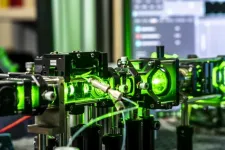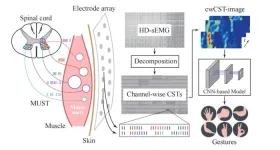(Press-News.org) Researchers from the University of Birmingham have uncovered answers that provide the detail to explain two specific DNA repair processes that have long been in question.
The publication of two papers demonstrates how work led by laboratories from the Department of Cancer and Genomic Sciences, and School of Biosciences at the University of Birmingham has made strides in understanding how the repair process is correctly orchestrated.
The importance of understanding DNA repair
Our cells protect their DNA by constantly monitoring and repairing any damage. When DNA is damaged, internal signals activate within the cell to pinpoint the damage and recruit specialised proteins—DNA repair "machines"—to fix the break. This repair process must be tightly regulated to ensure the correct proteins arrive in the right amounts and in the correct sequence.
Many chemotherapy treatments for cancers work by damaging DNA to stop replication and subsequent uncontrolled growth of tumours. Improvements in the understanding of complex DNA repair processes, such as knowing which proteins are enlisted and their specific roles and functions, have the potential to lead to refinements in future cancer treatments making them more effective at halting tumour growth.
“These discoveries help us understand how our cells work to repair damaged DNA correctly. As many chemotherapies work by damaging DNA, the discoveries provide information about new ways that anti-cancer therapies could be enhanced and new ones developed.”
Jo Morris, Professor of Molecular Genetics, Cancer and Genomic Sciences, University of Birmingham.
Repair signal switch
The first study, published in Nature Communications today (Monday 14 April), identifies a “twisting switch” that helps turn off early repair signals by altering the shape of proteins. Without the switch, repair signals stay active too long, disrupting the correct sequencing of the repair machine arrival at and exit from the broken site so that DNA repair is blocked.
The discovery of the twisting switch resolves a long-standing question about how the DNA repair protein RNF168, which has a tendency to cause uncontrolled signalling, is switched off. The paper outlines a four-step process that removes RNF168 from chromatin, preventing excessive DNA damage signals and demonstrates that without these steps, cells become hypersensitive to radiation.
Preventing repair signal overload
A second study published in Molecular Cell identified that a component previously assumed to have very little function in cells, SUMO4, has a crucial role to help prevent the DNA damage signal from being overwhelmed.
Without SUMO4, there is an excess of one type of signalling, disrupting other signals and preventing some repair proteins from reaching the damaged site. As a result, DNA repair fails. The significance of this research comes from the way it challenges earlier assumptions about the importance of the SUM04 protein.
END
Light bulb moment for understanding DNA repair switches
Advances in understanding how cells repair DNA damage could improve future cancer treatments
2025-04-14
ELSE PRESS RELEASES FROM THIS DATE:
New method for detecting nanoplastics in body fluids
2025-04-14
Microplastics and the much smaller nanoplastics enter the human body in various ways, for example through food or the air we breathe. A large proportion is excreted, but a certain amount remains in organs, blood and other body fluids. In the FFG bridge project Nano-VISION, which was launched two years ago together with the start-up BRAVE Analytics, a team led by Harald Fitzek from the Institute of Electron Microscopy and Nanoanalysis at Graz University of Technology (TU Graz) and an ophthalmologist from Graz addressed the question of whether nanoplastics also play a role in ophthalmology. The project partners have now been able to develop a method for detecting and quantifying nanoplastics ...
Do disasters delay early cancer diagnoses?
2025-04-14
Rates of colorectal cancer (CRC) diagnoses dropped during and shortly after Hurricanes Irma and Maria and the COVID-19 pandemic in Puerto Rico, according to a recent analysis. However, late-stage diagnoses eventually exceeded expectations, suggesting that limited access to cancer screening services due to these disasters likely hindered timely CRC diagnoses. The findings are published by Wiley online in CANCER, a peer-reviewed journal of the American Cancer Society.
During disasters, medical services may be delayed or inaccessible due to damaged infrastructure, overburdened health ...
Rise and shine: Natural light lessens morning fatigue
2025-04-14
Sleep is a necessary part of people’s daily routine, but modern lifestyles and technology have ushered in an era of decreased rest time and subsequent fatigue. Further, the bedroom environment, such as light, sound, and temperature, is important for a good night's sleep, though this is often neglected in residential architecture.
In search of a conclusive remedy, common sleep studies use artificial light that is easy to control. Osaka Metropolitan University researchers, however, believe natural light could be more effective for re-creating actual living environments.
To test this, Graduate School of Human Life and Ecology student Xiaorui Wang and Professor ...
Nature’s plan for delaying pest resistance deciphered
2025-04-14
Farmers in dozens of countries have embraced crops genetically engineered to produce proteins from Bacillus thuringiensis (Bt) bacteria that kill some key pests yet are safe for people and wildlife. Although this biotech approach reduces reliance on insecticide sprays thereby providing economic and environmental benefits, resistance to Bt crops has evolved in at least 11 species of pests. Thus, effective ways to combat such pest resistance are urgently needed.
A new study published in the Proceedings of the National Academy of Sciences identifies a natural strategy for thwarting pest resistance to Bt proteins. The researchers at the University of Arizona and ...
New guidance for managing obesity in children and adolescents
2025-04-14
A new guideline to help health care providers manage obesity in children and adolescents takes a patient-centred approach, emphasizing behavioural and psychological supports that focus on outcomes valued by patients and their families.
The guidelinehttps://www.cmaj.ca/lookup/doi/10.1503/cmaj.241456, based on the latest evidence, is published in CMAJ (Canadian Medical Association Journal).
It was developed by Obesity Canada through an extensive, 4-year-long collaboration involving adolescents and caregivers with lived obesity experience, methodologists, health care providers, and more than 50 multidisciplinary ...
High blood pressure? Eat more bananas
2025-04-14
New research from the University of Waterloo suggests increasing the ratio of dietary potassium to sodium intake may be more effective for lowering blood pressure than simply reducing sodium intake.
High blood pressure affects over 30 per cent of adults globally. It's the leading cause of coronary heart disease and stroke and may also lead to other afflictions like chronic kidney disease, heart failure, irregular heartbeats, and dementia.
"Usually, when we have high blood pressure, we are advised to eat less salt," said Anita Layton, professor of Applied Mathematics, ...
Weak evidence behind how we measure pain in babies
2025-04-14
A newly-published Cochrane review reveals significant gaps in the clinical rating scales used to assess pain in newborn babies, highlighting the urgent need for improved tools and global collaboration.
Despite the critical importance of accurately measuring pain in newborns, the review found that none of the available scales are backed by the high-quality evidence and methodological safeguards required to confirm their validity and reliability in clinical practice.
Neonatal pain assessment and management presents a challenge for clinical staff worldwide. Over 40 rating scales have been developed and adapted worldwide assessing ...
Novel breath test shows promise for diagnosing and monitoring bacterial infections
2025-04-13
This release has been removed upon request of the submitting institution. Please contact Luke Paskins, luke.paskins@beyondpr.com for more information. END ...
AI-guided lung ultrasound marks a major breakthrough in tuberculosis diagnosis
2025-04-13
(Monday, 14 April 2025, Vienna, Austria) A pioneering study presented today at ESCMID Global 2025 has demonstrated that an AI-powered lung ultrasound outperforms human experts by 9% in diagnosing pulmonary tuberculosis (TB).1
The ULTR-AI suite analyses images from portable, smartphone-connected ultrasound devices, offering a sputum-free, rapid, and scalable alternative for TB detection. The results exceed the World Health Organization (WHO) benchmarks for pulmonary tuberculosis diagnosis, marking a major opportunity for accessible and efficient TB triage.
Despite previous global declines, TB rates rose by 4.6% from 2020 to 2023.2 Early ...
Towards hand gesture recognition using a channel-wise cumulative spike train image-driven model
2025-04-13
A research paper by scientists at Shanghai Jiao Tong University presented a novel channel-wise cumulative spike train image-driven model (cwCST-CNN) for hand gesture recognition.
The research paper, published on Mar. 21, 2025 in the journal Cyborg and Bionic Systems, leverage a custom convolutional neural network (CNN) to extract both local and global features for classifying hand gestures, by decomposing high-density surface EMG (HD-sEMG) signals into channel-wise cumulative spike trains (cw-CSTs) ...
LAST 30 PRESS RELEASES:
Heart-brain connection: international study reveals the role of the vagus nerve in keeping the heart young
Researchers identify Rb1 as a predictive biomarker for a new therapeutic strategy in some breast cancers
Survey reveals ethical gaps slowing AI adoption in pediatric surgery
Stimulant ADHD medications work differently than thought
AI overestimates how smart people are, according to HSE economists
HSE researchers create genome-wide map of quadruplexes
Scientists boost cell "powerhouses" to burn more calories
Automatic label checking: The missing step in making reliable medical AI
Low daily alcohol intake linked to 50% heightened mouth cancer risk in India
American Meteorological Society announces Rick Spinrad as 2026 President-Elect
Biomass-based carbon capture spotlighted in newly released global climate webinar recording
Illuminating invisible nano pollutants: advanced bioimaging tracks the full journey of emerging nanoscale contaminants in living systems
How does age affect recovery from spinal cord injury?
Novel AI tool offers prognosis for patients with head and neck cancer
Fathers’ microplastic exposure tied to their children’s metabolic problems
Research validates laboratory model for studying high-grade serous ovarian cancer
SIR 2026 delivers transformative breakthroughs in minimally invasive medicine to improve patient care
Stem Cell Reports most downloaded papers of 2025 highlight the breadth and impact of stem cell research
Oxford-led study estimates NHS spends around 3% of its primary and secondary care budget on the health impacts of heat and cold in England
A researcher’s long quest leads to a smart composite breakthrough
Urban wild bees act as “microbial sensors” of city health.
New study finds where you live affects recovery after a hip fracture
Forecasting the impact of fully automated vehicle adoption on US road traffic injuries
Alcohol-related hospitalizations from 2016 to 2022
Semaglutide and hospitalizations in patients with obesity and established cardiovascular disease
Researchers ‘listen in’ to embryo-mother interactions during implantation using a culture system replicating the womb lining
How changing your diet could help save the world
How to make AI truly scalable and reliable for real-time traffic assignment?
Beyond fragmented markets: A new framework for efficient and stable ride-pooling
Can shape priors make road perception more reliable for autonomous driving?
[Press-News.org] Light bulb moment for understanding DNA repair switchesAdvances in understanding how cells repair DNA damage could improve future cancer treatments


